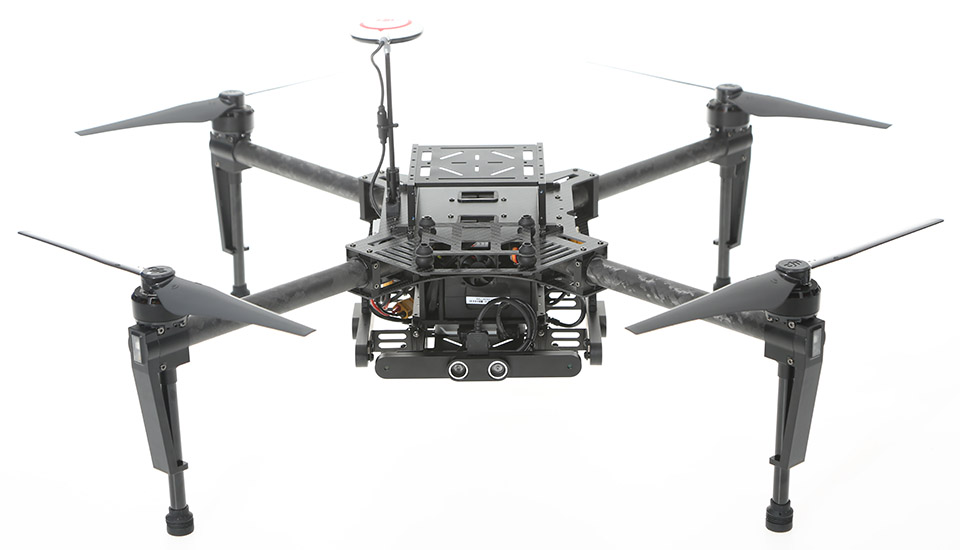DJI Matrice 100 with the "Guidance" Sense and Avoid System
 |
| DJI Matrice 100 |
DJI continues to position itself
at the forefront of high-end commercially developed UAVs, and when it comes to
sense and avoid, they are clearly ahead of the pack. In June of this year, DJI rolled out their
Matrice 100 drone that comes equipped with a sense and avoid system (Prindle,
2015).
The sense and avoid system,
called “Guidance” by DJI, uses a combination of visual and ultrasonic sensors
that are mounted fore, aft, left, right, and below the aircraft. This provides 360 degrees of sensing at the
horizon, as well as directly below the aircraft. The data from these sensors is fused using
DJI’s vision algorithms to perform the sense and avoid function. This system also helps the aircraft to hover
without GPS at altitudes of up to 65 feet (Guidance, n.d.). I did note the omission of a sixth sensor
mounted on top of the system that would provide coverage above the aircraft to
keep it from running into the ceiling or other obstructions such as tree limbs,
etc. In all of the various discussions
about this system, I couldn’t find a mention of this as being a concern.
 |
| The Guidance System with Five Sensors and Processor |
For the theory of operation on
this system, as stated above, the system fuses visual (electro-optical or EO)
and ultrasonic (sonar) sensors in order to provide the sense and avoid
capability. These sensors can be seen in
the image to the below:
Single EO and Ultrasonic Sensor
The two EO cameras closer to the center, and the
sonar sensors mounted farther out. The
EO sensors in this system provide a stereo matching in order to provide depth
through the parallax effect of objects when viewed from the two cameras, as
well as the ability to track motion (Sun, 2013). The ultrasonic sensors are used to measure
the actual distance from the object(s) that are being seen by the cameras (Wu,
2014). The vision algorithm fuses the
two modalities by continuously tracking visual information and updating the
overall world model of the system (Tabkhi, 2014).
Currently, the Matrice 100 is
the only DJI airframe that has this capability.
Unlike other DJI aircraft such as the Phantom 3 or Inspire, the Matrice
100 is “developer-friendly” and was built specifically to support experimental
research and development (Popper, 2015).
The Matrice 100 is available for around $3,300 from multiple sources
online.
Below
is a list of technical specification on the system from DJI’s website
(Guidance, n.d.):
Physical
Parameters |
Dimensions
|
Guidance Core: 78.5 mm
x 53.5 mm x 14 mm
|
Guidance Sensor: 170 mm
x 20 mm x 16.2 mm
| ||
VBUS Cable: 200mm
| ||
Weight
|
Guidance Core: 64 g
| |
Guidance Sensor
(single): 43 g
| ||
VBUS Cable (single):11.6g
| ||
Performance
Parameters |
Velocity Detection Range
|
0~16 m/s (From the
ground 2 m) (The measurement shall prevail)
|
Velocity Detection Accuracy
|
0.04 m/s (From the
ground 2 m)
| |
Positioning
Accuracy |
0.05 m (From the ground
2 m)
| |
Effective Sensor
Range |
0.20 m ~ 20 m
| |
External
Requirements |
Good lighting
| |
Texture-rich surface
with clear patterns
| ||
Hardware
Parameters |
Power
Consumption |
Max. 12 W (with all
five Guidance Sensors)
|
Input Voltage
|
11.1 V~25 V
| |
Operating
Temperature |
-10°C ~ 40°C
| |
System Interfaces
|
VBUS ✕ 5
| |
CAN ✕ 1
| ||
USB OTG 2.0 ✕ 1
| ||
UART ✕ 1
| ||
UART Level
|
3.3V
|
References:
Guidance.
(n.d.). Retrieved December 5, 2015, from https://developer.dji.com/guidance/
Popper,
B. (2015, June 8). DJI just released the first consumer drone that can see and
avoid obstacles. Retrieved December 5, 2015, from
http://www.theverge.com/2015/6/8/8745415/dji-guidance-system-matrice-100-sense-avoid
Prindle,
D. (2015, June 9). DJI’s new obstacle avoidance tech aims to make drones crash
proof. Retrieved December 4, 2015, from
http://www.digitaltrends.com/cool-tech/dji-obstacle-avoidance-matrice-100-guidance/
Sun, H., Zou, H., Zhou, S., Wang, C., &
El-Sheimy, N. (2013). Surrounding Moving Obstacle Detection for Autonomous
Driving Using Stereo Vision. Int J Adv Robotic Sy International Journal of
Advanced Robotic Systems, 1-1.
Tabkhi,
H., Sabbagh, M., & Schirner, G. (2014). Power-efficient real-time solution
for adaptive vision algorithms. IET Computers & Digital Techniques, 16-26.
Wu, S. (2014). An optimized ultrasonic sensors
system. Sensors & Transducers, 182(11), 33-41. Retrieved from
http://search.proquest.com.ezproxy.libproxy.db.erau.edu/docview/1635079504?accountid=27203

No comments:
Post a Comment